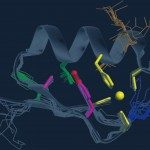Link to Pubmed [PMID] – 15064474
Methods Mol. Biol. 2004;261:427-42
In the cell, homo- and heteroassociations of polypeptide chains evolve and take place within subcellular compartments that are crowded with many other cellular macromolecules. In vivo chemical cross-linking of proteins is a powerful method to examine changes in protein oligomerization and protein-protein interactions upon cellular events such as signal transduction. This chapter is intended to provide a guide to the selection of the cell-membrane-permeable cross-linkers, the optimization of in vivo cross-linking conditions, and the identification of specific cross-links in a cellular context where the frequency of random collisions is high. By combining the chemoselectivity of the homo-bifunctional cross-linker and the length of its spacer arm with knowledge on the protein structure, we show that selective cross-links can be introduced specifically on either the dimer or the hexamer form of the same polypeptide in vitro as well as in vivo, using the human type B nucleoside diphosphate kinase as a protein model.

